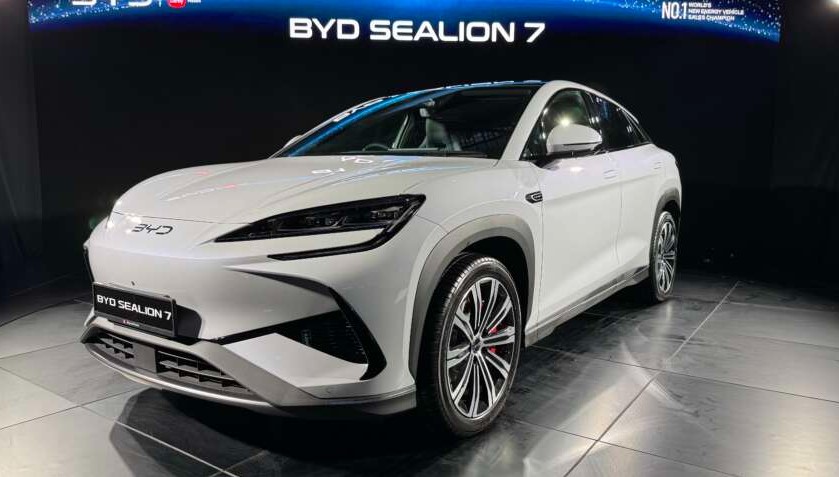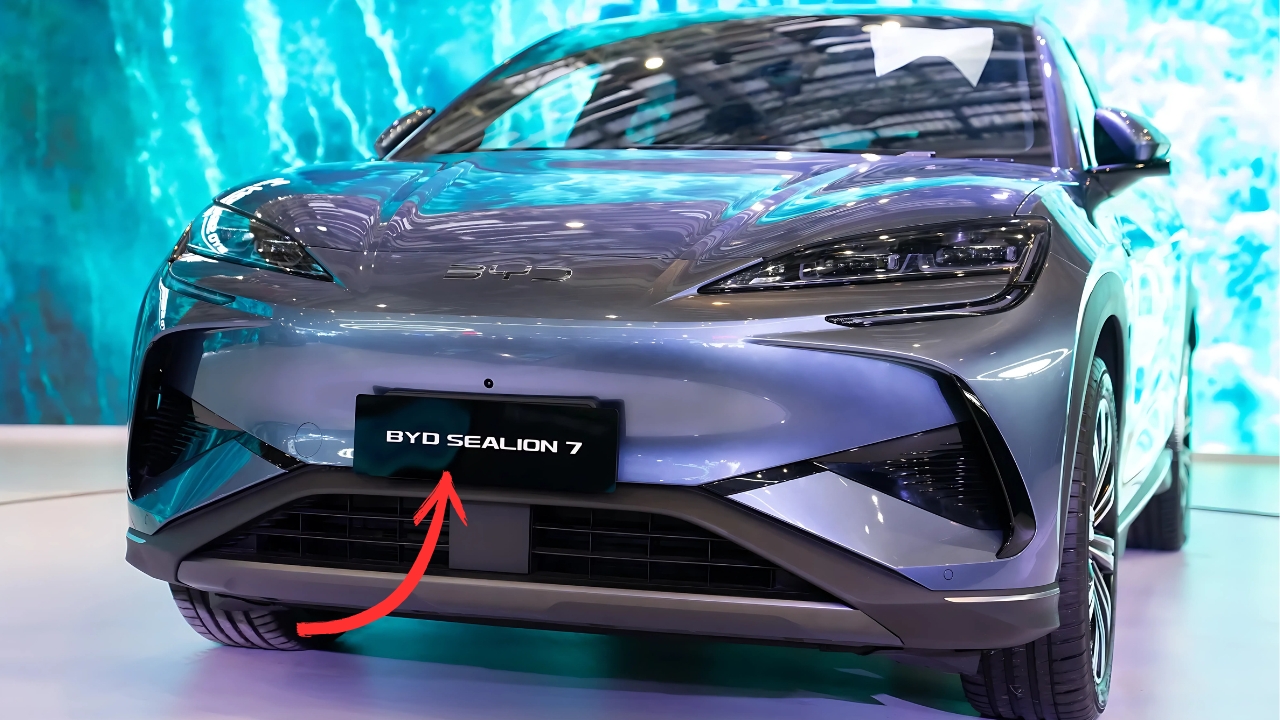BYD Sealion 7: The electric vehicle landscape in Australia is heating up, and BYD’s Sealion 7 has officially launched in February 2025, bringing game-changing CTB (Cell-to-Body) technology to Aussie roads.
This isn’t just another electric SUV – it’s a engineering masterpiece that’s redefining what chassis strength means in the EV world.
Priced from $54,990 plus on-road costs, the Sealion 7 is taking direct aim at the Tesla Model Y’s dominance. But what makes this Chinese-built SUV truly special is how BYD has integrated their revolutionary battery technology directly into the vehicle’s structure, creating something that feels more like a luxury sedan than a typical electric crossover.
What Makes CTB Technology a Game-Changer?
CTB (Cell-to-Body) technology represents the next evolution in electric vehicle design. Unlike traditional battery pack designs, CTB integrates battery cells directly into the vehicle’s structure rather than housing them in a separate battery pack. Think of it as turning your car’s battery into part of the actual skeleton.
The BYD Seal was the first vehicle to implement CTB technology, which fully integrates the BYD Blade Battery into the entire vehicle structure and enhances safety. The Sealion 7 takes this concept and perfects it for the SUV segment.
Here’s how it works: The battery pack’s upper cover replaces the traditional vehicle floor, creating what engineers call a “sandwich structure.” This design forms a structure similar to honeycomb aluminum plates, dramatically improving the battery pack’s structural strength. The result? A vehicle that’s not just carrying a battery – it’s built around one.
The Engineering Magic Behind CTB
This integration has led to remarkable improvements, with a 70% increase in torsional stiffness and a 57% increase in bending stiffness of the body. What does this mean for you as a driver? Better handling, reduced body flex during cornering, and that solid, planted feeling you get in premium luxury cars.
BYD’s CTB technology achieves a volume utilization rate of 66% and torsional stiffness exceeding 40,000 N·m/° – that’s luxury car territory. For perspective, that’s the kind of rigidity you’d expect from a Mercedes S-Class or BMW 7 Series.
Why Australian Roads Need This Level of Strength
Australia’s driving conditions are uniquely challenging. From the urban stop-and-go of Melbourne and Sydney to the harsh outback highways, our roads demand vehicles that can handle everything. CTB technology addresses these challenges head-on.
The enhanced torsional rigidity means the vehicle experiences less body roll when turning at high speeds, keeping the body stable and giving drivers strong confidence. Whether you’re navigating winding mountain roads in the Blue Mountains or dealing with sudden lane changes on the M1, this translates to better control and safety.
Built to Handle Impact
Safety isn’t just about airbags and sensors – it’s about structural integrity. CTB technology reduces vehicle side column collision intrusion by 45%. This means in the unfortunate event of a side impact, the reinforced structure provides better protection for passengers.
Even if the battery pack is crushed by a 50-ton truck, the cells can maintain their integrity with no smoke or fire. That’s the kind of peace of mind you want when sharing the road with heavy transport vehicles on Australian highways.
Sealion 7: Specifications That Matter
The BYD Sealion 7 comes in two variants tailored for Australian conditions: the Premium RWD with 230kW/380Nm and the Performance AWD generating 390kW/690Nm. Both versions use the same 82.56kWh BYD Blade battery, with the Premium offering 482km range and the Performance delivering 456km.
The Performance variant rockets from 0-100km/h in just 4.5 seconds – that’s supercar territory in an SUV body. The 23,000 RPM electric motors represent the highest-spinning motors BYD has ever produced, delivering that instant torque we love about electric vehicles.
iTAC: Intelligence Meets Performance
The Sealion 7 features iTAC (Intelligent Torque Adaptation Control) technology, which goes beyond traditional power reduction methods by intelligently allocating drive torque. This system uses torque shift, appropriate torque reduction, and negative torque output to minimize or eliminate skidding.
For Australian drivers, this means confidence in all conditions – whether you’re dealing with sudden summer downpours in Queensland or navigating slippery winter roads in Tasmania.
How CTB Transforms the Driving Experience
The beauty of CTB technology isn’t just in the numbers – it’s in how it feels. BYD Seal drivers note that the car feels ergonomically closer to a traditional internal combustion engine vehicle, and the Sealion 7 carries this advantage into the SUV segment.
Lower center of gravity is a natural benefit of integrating the battery into the chassis. This allows the vehicle to sit lower for better aerodynamics and improves body stiffness. The result is an SUV that handles more like a sports sedan while maintaining the practical benefits of higher seating and cargo space.
Comfort Meets Performance
The Sealion 7 features front double-wishbone and rear multi-link suspension setup, along with FSD (Frequency Selective Damping) shock absorbers. This advanced system adjusts in real-time to deliver a smooth, stable ride by adapting to different road conditions.
Whether you’re cruising through the urban jungle of Perth or tackling the varied terrain between Adelaide and Alice Springs, the suspension works with the reinforced CTB structure to deliver a ride quality that rivals vehicles costing twice as much.
Competitive Edge in the Australian Market

With the Tesla Model Y starting at $63,400, the Sealion 7’s $54,990 starting price represents serious value. But it’s not just about price – it’s about what you’re getting for your money.
While Tesla pioneered many EV technologies, BYD’s CTB represents a more advanced integration approach compared to Tesla’s Cell-to-Chassis (CTC) technology. The result is a vehicle that feels more refined and better suited to Australian driving conditions.
Safety and Practicality
The Sealion 7 includes BYD’s Driver Assistance Suite, comprising Adaptive Cruise Control, Lane Keeping Assist, and Autonomous Emergency Braking, plus a 360-degree camera system. Combined with the structural benefits of CTB, you’re getting comprehensive safety coverage.
The spacious interior benefits from the efficient packaging that CTB allows. CTB increases volume utilization by 66% and vertical space by 10mm, meaning more room for passengers and cargo without increasing the overall vehicle footprint.
The Future of EV Chassis Design
Currently, only four automakers – Tesla, BYD, Leapmotor, and Xpeng – have released CTC/CTB technology in production models. BYD’s implementation stands out for its focus on safety and structural integrity rather than just cost reduction.
The engineering benefits extend beyond just strength. CTB technology can enhance overall vehicle strength while reducing battery component weight, and simplified body structure naturally reduces body vibration. This means a quieter, more refined driving experience that Australian families will appreciate.
Manufacturing Advantages
Because the CTB structure is less complicated than traditional battery packs, it reduces parts usage, makes production more efficient, and offers better cost-effectiveness. These manufacturing benefits translate to better value for consumers and more reliable long-term ownership.
What This Means for Australian Drivers
The BYD Sealion 7 represents more than just another electric SUV option – it’s a glimpse into the future of vehicle construction. The integration of CTB technology delivers tangible benefits that matter to real-world driving:
Enhanced safety through improved structural integrity and crash protection. Better handling thanks to increased torsional rigidity and lower center of gravity. Superior ride quality from the combination of advanced suspension and rigid chassis construction.
Australian deliveries begin in February 2025, and early indicators suggest strong demand. The combination of competitive pricing, advanced technology, and impressive performance specifications positions the Sealion 7 as a serious contender in Australia’s growing electric vehicle market.
For Australian drivers ready to embrace the electric future, the Sealion 7 offers something unique: cutting-edge battery integration technology wrapped in a practical, family-friendly SUV that doesn’t compromise on performance or safety.
Frequently Asked Questions
Q: How does CTB technology differ from traditional battery mounting? A: CTB integrates the battery directly into the vehicle structure, making it a structural component rather than just a power source, resulting in 70% better torsional stiffness.
Q: Is the Sealion 7 available for order now in Australia? A: Yes, the Sealion 7 launched in Australia in February 2025 with expressions of interest available through BYD dealers and the official website.
Q: What’s the warranty coverage for the CTB battery system? A: BYD offers an 8-year or 160,000km warranty on the traction battery and 6-year or 150,000km vehicle warranty.

